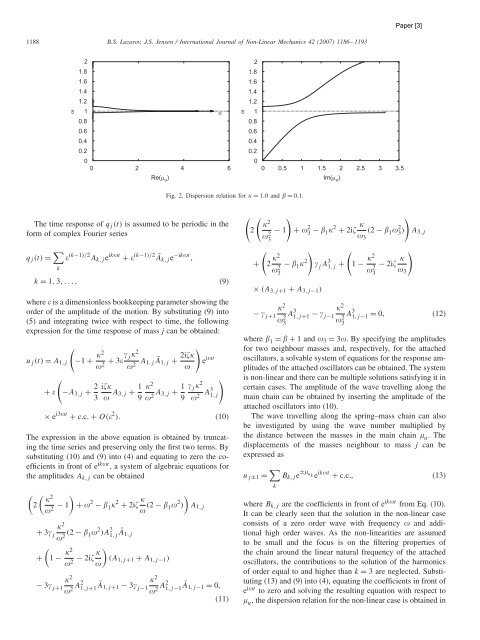WAVES AND VIBRATIONS IN INHOMOGENEOUS STRUCTURES ...
WAVES AND VIBRATIONS IN INHOMOGENEOUS STRUCTURES ...
WAVES AND VIBRATIONS IN INHOMOGENEOUS STRUCTURES ...
You also want an ePaper? Increase the reach of your titles
YUMPU automatically turns print PDFs into web optimized ePapers that Google loves.
1188 B.S. Lazarov, J.S. Jensen / International Journal of Non-Linear Mechanics 42 (2007) 1186 –1193<br />
ω<br />
2<br />
1.8<br />
1.6<br />
1.4<br />
1.2<br />
1<br />
0.8<br />
0.6<br />
0.4<br />
0.2<br />
0<br />
0 2 4 6<br />
The time response of qj (t) is assumed to be periodic in the<br />
form of complex Fourier series<br />
qj (t) = <br />
(k−1)/2 Ak,je ikt + (k−1)/2 Āk,je −ikt ,<br />
k<br />
k = 1, 3,..., (9)<br />
where is a dimensionless bookkeeping parameter showing the<br />
order of the amplitude of the motion. By substituting (9) into<br />
(5) and integrating twice with respect to time, the following<br />
expression for the time response of mass j can be obtained:<br />
<br />
uj (t) = A1,j −1 + 2<br />
2 + 3 j 2 2 A1,j Ā1,j + 2i<br />
<br />
e<br />
<br />
it<br />
<br />
+ −A3,j + 2 i<br />
3 A3,j + 1 <br />
9<br />
2<br />
2 A3,j + 1 j <br />
9<br />
2<br />
2 A3 <br />
1,j<br />
× e i3t + c.c. + O( 2 ). (10)<br />
The expression in the above equation is obtained by truncating<br />
the time series and preserving only the first two terms. By<br />
substituting (10) and (9) into (4) and equating to zero the coefficients<br />
in front of e ikt , a system of algebraic equations for<br />
the amplitudes Ak,j can be obtained<br />
<br />
2 <br />
2 − 1 + <br />
2 2 − 1 2 + 2i <br />
(2 − 1 2 <br />
) A1,j<br />
2<br />
+ 3j 2 (2 − 1 2 )A 2 1,j Ā1,j<br />
<br />
+ 1 − 2<br />
<br />
<br />
− 2i<br />
2 <br />
− 3 j+1<br />
(A1,j+1 + A1,j−1)<br />
2 2 A21,j+1Ā1,j+1 <br />
− 3j−1 2<br />
2 A21,j−1Ā1,j−1 = 0,<br />
∞<br />
ω<br />
Re(μ u ) Im(μ u )<br />
2<br />
1.8<br />
1.6<br />
1.4<br />
1.2<br />
1<br />
0.8<br />
0.6<br />
0.4<br />
0.2<br />
Fig. 2. Dispersion relation for = 1.0 and = 0.1.<br />
(11)<br />
<br />
2<br />
0<br />
0 0.5 1 1.5 2 2.5 3 3.5<br />
<br />
2<br />
2 3<br />
<br />
− 1 + 2 3 − 1 2 + 2i <br />
(2 − 1 2 3 )<br />
<br />
3<br />
<br />
+ 2 2<br />
2 − 1 3<br />
2<br />
<br />
j A 3 1,j +<br />
<br />
1 − 2<br />
2 − 2i<br />
3<br />
<br />
<br />
3<br />
× (A3,j+1 + A3,j−1)<br />
− j+1<br />
2<br />
2 3<br />
A 3 1,j+1 − j−1<br />
2 2 A<br />
3<br />
3 1,j−1<br />
A3,j<br />
= 0, (12)<br />
where 1 = + 1 and 3 = 3. By specifying the amplitudes<br />
for two neighbour masses and, respectively, for the attached<br />
oscillators, a solvable system of equations for the response amplitudes<br />
of the attached oscillators can be obtained. The system<br />
is non-linear and there can be multiple solutions satisfying it in<br />
certain cases. The amplitude of the wave travelling along the<br />
main chain can be obtained by inserting the amplitude of the<br />
attached oscillators into (10).<br />
The wave travelling along the spring–mass chain can also<br />
be investigated by using the wave number multiplied by<br />
the distance between the masses in the main chain u. The<br />
displacements of the masses neighbour to mass j can be<br />
expressed as<br />
uj±1 = <br />
k<br />
Bk,je ± u k e ikt + c.c., (13)<br />
where Bk,j are the coefficients in front of e ikt from Eq. (10).<br />
It can be clearly seen that the solution in the non-linear case<br />
consists of a zero order wave with frequency and additional<br />
high order waves. As the non-linearities are assumed<br />
to be small and the focus is on the filtering properties of<br />
the chain around the linear natural frequency of the attached<br />
oscillators, the contributions to the solution of the harmonics<br />
of order equal to and higher than k = 3 are neglected. Substituting<br />
(13) and (9) into (4), equating the coefficients in front of<br />
e it to zero and solving the resulting equation with respect to<br />
u, the dispersion relation for the non-linear case is obtained in

















